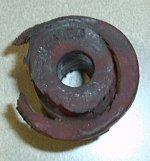toobroketoretire
Banned
I just received my set of Energy Suspension polyurethane upper and lower control arm bushings and I have to admit they look terrific. I have always used the common MOOG rubber bushings at about 1/3rd the price so it'll be interesting to see how long these things last. These polyurethane bushings come in three pieces; the heavy wall thickness outer sleeve that gets pressed into the control arm, the polyurethane bushing that is a tight "slip fit", and the heavy wall thickness inner sleeve that is also a tight slip fit. The bushings have 8 grooves in their bores that a special semi-clear lithium soap grease is applied into and that grease is included in the $72 set.
My MOOG bushings failed in about 5 years/100,000 miles because the rubber bushing literally squashed down to nothing which made my caster and camber angles increase over one degree. The polyurethane bushings are a LOT harder than the rubber bushings so I'm hoping they'll last a long time.
How many of you guys are using these polyurethane bushings in your control arms? Are you happy with them so far?
My MOOG bushings failed in about 5 years/100,000 miles because the rubber bushing literally squashed down to nothing which made my caster and camber angles increase over one degree. The polyurethane bushings are a LOT harder than the rubber bushings so I'm hoping they'll last a long time.
How many of you guys are using these polyurethane bushings in your control arms? Are you happy with them so far?





